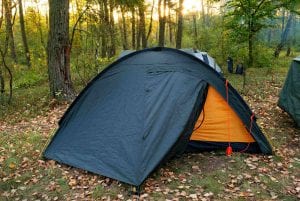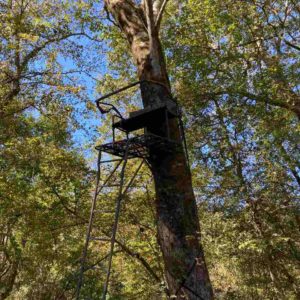So, you have all your gear and you’re ready to head out into the wild and set up camp. Why is a tarp a helpful addition and what do you use a tarp for in camping anyway?
For many experienced campers, a tarp is a must-have piece of equipment. In today’s article, we’ll look at the multiple ways you can use a tarp when you next go camping.
What do you use a tarp for in camping? Here are a few ideas:
- Camp kitchen area or private bathroom
- Extra waterproofing
- Hiking shelter
- Shade
- As a footprint
1. Create a Camp Kitchen Area
When camping, you never know what Mother Nature is going to throw at you. With that in mind, it’s good to be prepared and have a sheltered place to cook.
Try a similar set up to create a campsite bathroom, you can even add another tarp for privacy.
What to Buy
You’ll need a large tarp to give your outdoor kitchen enough coverage. You can use cheaper tarps but for more versatility, a high-quality tarp is best.
Apart from the tarp itself, you’ll need, poles, stakes, and guylines.
How to Set It Up
Follow these quick steps:
- Set up your poles, you can also use trees if there are any in the vicinity
- Set up a ridgeline
- Lay the tarp over the line
- Guy out the corners
2. Over Your Tent for Extra Waterproofing
This isn’t completely necessary since most tents come with a waterproof rainfly. But as many campers know, a rainfly won’t last forever. If yours has seen better days or you want extra protection against the elements, adding a tarp is a cheap, effective option.
You can also extend the tarp out past the tent itself to create an awning or even a vestibule if needed.
What to Buy
Go for a light, high-quality tarp, avoid cheap polyester. It should be large enough to cover your tent or create an awning. Don’t forget to pick up some guylines, poles, and pegs.
How to Set It Up
Use your tarp as a rainfly when camping:
- Set up the poles as needed
- Create a ridgeline running between the two poles
- Hang the tarp over the line
- Use guylines to extend the corners away from the tent and down
3. Shelter Your Hiking Lunch Break
A light tarp is an excellent addition to your hiking backpack. It’s not heavy to carry and is easy to set up when you need shelter. When you finally sit down for a break and a bite to eat, the tarp can act as a sunshade, rain cover, or protection against winds.
What to Buy
For hiking, you don’t want anything heavy. Quality isn’t really important for this use since you only need a little protection from the weather.
How to Set It Up
There are different ways to set the tarp up. You can use the same steps detailed above using poles and guylines. If you’re in the woods, skip the poles and use trees.
4. Use as a Sunshade
The sun can get hot during the day, so it’s nice to have an extra shade to relax in. You can set up your shade tarp independently to your tent or, as I mentioned above, create an awning.
What to Buy
You have a couple of options here. Either keep it simple and invest in a beach canopy. Or use a decent 10 by 10 silnylon tarp. Use poles and guylines to set it up.
5. Make a Windbreak
It can be hard enough to gather your thoughts—let alone your rainfly—in windy weather! I recommend using your tarp to catch a break. Just make sure it’s secured properly so it won’t fly away.
Alternatively, use the windbreak as a makeshift shelter for your furry camping companion.
What to Buy
There’s no specific type of tarp to use as a windbreak. You can easily do with a cheaper polyester tarp but if you want a tarp that can do double duty, consider a quality model. Make sure the tarp is big enough to make an effective windbreak.
You also need tent pegs and guylines or bungees.
How to Set It Up
Follow these steps:
- Set the tarp up between two trees or poles using guylines or bungees. Position the tarp so it blocks the wind.
- Use the pegs to secure the bottom edge of the tarp to the ground. You can use this to sit on.
6. Cover Your Equipment
To keep your equipment dry and out of the elements.
What to Buy
Any basic and affordable blue tarp will do.
How to Set It Up
Lay your equipment out and cover your stuff with the tarp. Baton it down for extra waterproofing.
7. For Sleeping Under
If you don’t want to cart a tent around or you like to be closer to nature and free camp. A tarp creates an excellent makeshift tent in case the weather gets the better of you.
What to Buy
For this, you’ll want a good quality tarp of silnylon or cuben fiber. A square tarp makes an excellent shelter but rectangle-shaped tarps are effective too.
Additionally, you’ll need guylines or rope, stakes, and poles or trees.
How to Set It Up
Here’s an easy set-up:
- Use a guyline, rope or bungee to tie one end of the tarp to a tree (about six feet high will do)
- Draw out the opposite corner and secure it in the ground with stakes
- Stake out the other sides and you’ve successfully mastered the diamond pitch
So, what do you use a tarp for in camping? The possibilities are endless! Plus, they are cheap alternatives to more expensive gear, such as dedicated tent footprints.
8. Use as a Tent Footprint
A tent footprint is a handy addition to your camping tool kit. It’s basically a layer of material between your tent’s base and the ground.
There are many reasons why you need a footprint, including but not limited to:
- Protect your tent: Tents are expensive, you want to take care of yours as much as possible. Small stones, twigs, or other sharp items can cause abrasion or cuts on your tent’s. Use a tarp as a groundsheet and it takes the beating instead of your tent.
- Add waterproofing: Waking up in a puddle? No thanks. Although your tent might have a tub floor, it’s no guarantee that water won’t accidentally creep into your abode. The tarp adds a double layer of protection between you and the elements.
What to Buy
Ideally, you should buy a dedicated footprint for your tent. But, you can also make your own footprint using a polyester tarp. Make sure it’s slightly smaller than the outline of your tent, or else water could pool.
How to Set It Up
Simply lay it out flat on the ground before pitching your tent on top of it.





